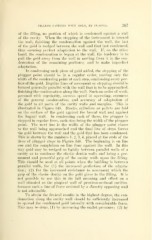Page 567 - My FlipBook
P. 567
FILLING CAVITIES WITH GOLD, BY CLASSES. 267
of the filling, no portion of which is condensed against a wall
of the cavity. When the stepping of the instrument is toward
the wall, finishing the condensation against the wall, the last
of the gold is wedged between the wall and that hist condensed,
thus securing perfect adaptation to the wall. If, on the other
hand, the condensation is begun at the wall, tlie tendency is to
pull the gold away from the wall in moving from it in the con-
densation of the remaining portions; and to make imperfect
adaptation.
In condensing each piece of gold added, the stepping of the
pliigger ]ioint should I)e in a regular order, moving onlj' the
width of the condensing point at each step, condensing every por-
tion of the gold. Regular lines of movement or stejjping should l)e
formed generally parallel with the wall that is to be approached,
finishing the condensation along the wall. Such an order of work,
pursued with regularity, secures speed in operating, evenness
of the general condensation, and accuracy of adaptation of
the gold to all parts of the cavity walls and margins. This is
illustrated in Figure 348. Blocks, cylinders or pellets are laid
on the surface of the gold against the buccal wall and against
the lingual wall. In condensing each of these, the plugger is
stepped in regular lines, each step being the width of the plugger
point. The next line is the width of the plugger point closer
to the wall being approached and the final line of steps forces
the gold between the wall and the gold that has been condensed.
This is shown by the numbers 1, 2, 3, 4, placed at the ends of the
lines of plugger steps in Figure 348. The beginning is on line
one and the completion on line four against the wall. In this
way gold may be wedged so tightly between parallel walls of a
cavity as to condense the elastic dentin walls and bring a per-
manent and powerful grip of the cavity walls upon the filling.
This should be used at all i)oiuts when the building is between
parallel walls, for (1) the increased perfection of the adapta-
tion; (2) for the increased resistance to movement which the
grip of the elastic dentin on the gold gives to the filling. It is
not possible to use this in its full meaning and effect on a
wall situated as the gingival wall of proximo-occlusal cavities,
because such a line of force resisted by a directly opposing wall
is not attainable.
To attain the desired results in the highest degree, the con-
densation along the cavity wall should be sufficiently increased
to spread the condensed gold laterally with considerable force.
This may be done, (1) by increasing the mallet pressure; (2) by


